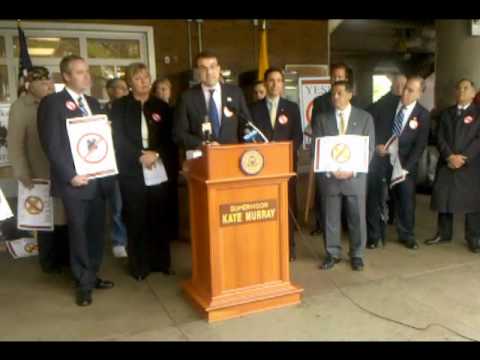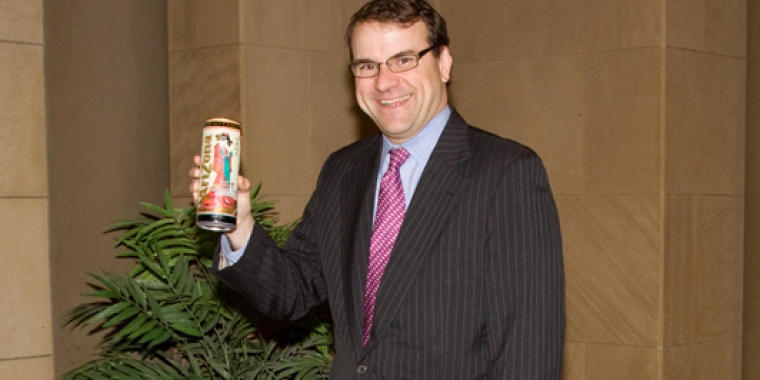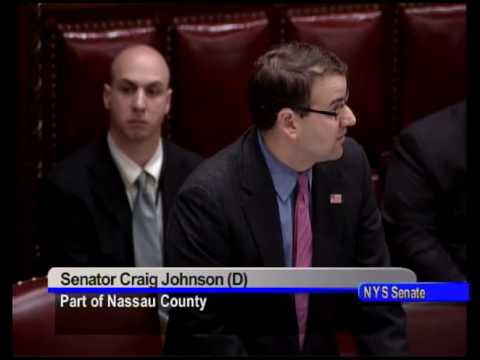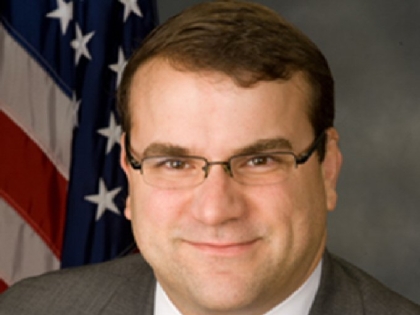
Sen. Johnson, Suburban Senate Dems, Unveil Tax Relief Plan
Craig M. Johnson
April 19, 2009
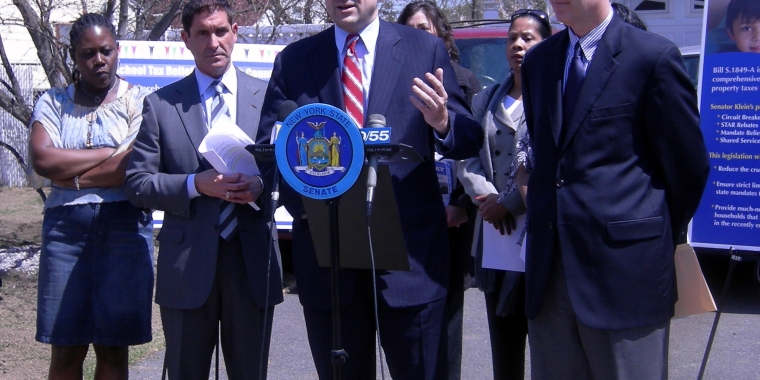
For Release- April 20, 2009
Sen. Johnson, Suburban Senate Dems, Unveil Tax Relief Plan
Proposal Includes STAR Rebate Restoration, Circuit Breaker for Middle Class Homeowners
Senator Craig M. Johnson (D-Nassau) was joined by fellow Long Island Senator Brian X. Foley (D-Suffolk), Deputy Senate Majority Leader Jeff Klein (D-Westchester/Bronx), Long Island homeowners and school officials to unveil their proposal to provide real relief to middle class homeowners who are struggling under the crippling burden of property taxes.
The plan would reinstate the Middle Class STAR rebate program for this year, as well as institute a circuit breaker for next year that offers tax relief based on how much of a property owner’s income is spent on property taxes. It also offers school districts much-needed relief from tax-hiking unfunded mandates.
“This responsible, comprehensive and realistic legislation would not only provide much-needed tax relief to residents, but it will also alleviate many of the unfunded mandates on schools that have driven up spending and caused property taxes to skyrocket,” Senator Johnson said. “This multi-pronged approach is what is needed break the cycle of out-of-control property tax increases and once again make Long Island affordable.”
“Thousands of New Yorkers are looking to us, a public servants, to develop a solution that helps them continue to enjoy the dream of homeownership, be able to provide for their families and offer their children a quality education. It is our responsibility to provide real and immediate relief for New Yorkers. This plan provides targeted and progressive tax relief and puts money back in the pockets of those who need it most," Senator Klein said.
Residents of Westchester and Nassau counties lead the state paying an average of $7,908 and $7,726 in property taxes respectively. Suffolk County isn’t far behind -- ranking 5th with $6,502. School property taxes have grown at an average rate of 7% per year since 2001-02 (42% statewide since 2000), which is twice the rate of inflation and twice the growth of average salaries. This steep rise in taxes has occurred despite the relief provided through the School Tax Relief (STAR) Program enacted in 1997.
“We are working hard to deliver real, substantial property tax relief for Long Islanders,” said Senator Foley. “The circuit breaker, along with the restoration of the STAR Rebate Checks will put money back in the pockets of struggling families and help stabilize and stimulate our economy.”
New York State collects $41 billion in property taxes, $26.3 billion of which is collected by school districts.
Under the bill:
The Middle Class STAR rebate program would be restored immediately for 2009 at the same level of benefits paid in 2008. However, starting in 2010, rebate checks issued to homeowners under this program will subtract out the amount of any circuit breaker tax credit already claimed in the same taxable year. This will avoid duplication of benefits while insuring that homeowners receive the maximum amount available to them under either plan. THE BASIC AND ENHANCED SENIOR STAR EXEMPTIONS, WHICH WERE FULLY RESTORED UNDER THE 2009-2010 BUDGET, WILL REMAIN UNAFFECTED.
The Circuit Breaker Tax Credit would provide targeted tax relief, beginning in 2010, to households earning up to $250,000 per year and paying more than a threshold percentage of their income on local school taxes. The precise threshold of 6, 7 or 8% would be based on rising household income categories, with the lowest income households (earning up to $90,000 per year upstate or $120,000 per year downstate) qualifying if school taxes consume more than 6% of their income. For instance, under Klein’s proposal, a homeowner making $40,000/year and paying $8,000 in school taxes (or 20% of their income) would receive roughly $3,920 in tax credits. That’s 70% of the overage ($5,600) from the circuit breaker point of 6% (of income).
State Mandate Relief would reduce the growth in school spending without depriving districts of the funding necessary to provide quality education services. In addition to rolling back many existing paperwork and reporting mandates that contribute to escalating school district costs, the bill imposes strict limits on the imposition of any new state-initiated mandates. Legislative and regulatory mandates not required by federal law or initiated by local request would be required to contain detailed costs estimates and a proposed source of funding if their implementation would cost any district more than $10,000 or more than $1,000,000 statewide. As an added protection, new state mandates would not be able to take effect in the middle of a school year, but would have to wait until they are funded in the next state budget.
District cost containment is also encouraged by an expansion in the powers of boards of cooperative educational services to offer shared services to reduce costs to their component districts. Local BOCES would be empowered to offer added cost savings by forming health insurance trusts with component school districts to purchase and administer employees’ health insurance and workers compensation insurance. They would also be able to generate additional savings by offering shared educational and administrative services to the Big 4 districts of Buffalo, Rochester, Yonkers and Syracuse for the first time.
The cost to restore the STAR rebate program is roughly $1.5 billion. Potential revenue streams to fund the restoration include:
$600 million from the Rainy Day Fund ($175 million) and Tax Stabilization Reserve Fund ($1.031 billion)
*
The Tax Stabilization Reserve Fund can be used for “unplanned budget gaps” while the Rainy Day Fund is triggered after five months of economic decline (as measured by a formula developed by the Division of Budget). According to a 2001 publication by the Center on Budget and Policy Priorities, prudent use of reserves doesn’t impact the state’s credit rating. Similarly, using the reserves means “taking money out of savings in order to increase consumption, which in the short run has a positive impact on the economy…using rainy day funds allows states to minimize the damaging effects of spending cuts and tax increases.”
*
According to a 2009 NY Association of Convenience Stores report, there is about $1 billion in cigarette sales between Native American tribes and non-tribal customers that is untaxed.
*
70.63% of tax collection goes to HCRA (Health Care Reform Act). However, providing money to HCRA would free up other monies to be used elsewhere in the budget, namely STAR rebate checks in 2009.
$184 million from new Video Lottery Terminal (VLT) games (Klein Bill - S706)
$375 million Up Front Payment for VLTs at Belmont Race Track for FY 2010-11 (C. Johnson Bill- S2827)
*
Currently no racino is allowed to stay open past 2 am.
*
Clarifying that the State’s Lottery program can offer electronic table games and random-number generator games like roulette and blackjack, in addition to increased revenues from Concord or Aqueduct (2010).
*
Racinos with more than 1,750 video lottery terminals will be allowed to stay open 140 hours a week while those with less than 1,750 video lottery terminals will be permitted to allow gambling 128 hours a week. Individual racinos will be able to determine daily hours, subject to approval by the Lottery Director
$27.5 million to the State from Rebate Parity for Generic Drugs
*
Under federal law, drug manufacturers (both generic and brand name drug manufacturers) must provide rebates to the state government to participate in Medicaid.
*
Brands are required by federal law to provide a minimum 15.1 percent of the Average Manufacturer Price (AMP) while generics are only required to provide a federally mandated flat 11 percent.
*
The state has the jurisdiction to add supplemental rebates owed to the state above the base amount mandated by the federal government.
+
Brands currently pay a supplemental amount in NYS (the best price offered by the brand name drug manufacturer to any private consumer and any price increase that exceeds the Consumer Price Index) beyond the federally required minimum base of 15 percent, which is split between federal and state governments.
*
Generics do not have a supplemental amount they must pay NYS
*
Since generic companies don't incur drug development research costs that brand name ones do, rebates should be more equal to brand-name drug manufacturers.
*
Pass-through costs by generics drug manufacturers to consumers would be limited because insured pay co-payments, not retail price of drugs.
$400 million from the Tax Amnesty Program
*
New York loses billions each year in tax revenues owed but not collected, known as the “tax gap”;
*
Current estimates indicate $4.2 billion in outstanding tax warrants are active and collectible;
*
A comprehensive tax amnesty program which would waive penalties and reduce applicable rates of interest in exchange for full payment of unpaid liabilities from eligible taxpayers could generate substantial revenues of more than $400 million assuming less than 10% collection rate;
*
The last tax amnesty offered in NYS in 2002 granted amnesty to over 285,000 taxpayers, totaling over $525 million in gross revenues from an estimated tax gap of $2.858 billion.
*
In addition to the tax amnesty program, proposals will be put in place to restrict taxpayers who have outstanding state tax liabilities from re-registering their vehicles through the state Department of Motor Vehicles and a list of all taxpayers and the amount of their outstanding tax liability will be made publicly available on a state maintained website.
$7.869 billion from the Federal Stimulus Fund
*
Federal stimulus money to NYS was $24.636 billion.
*
A combined $7.2 billion was spent/appropriated in the ’08-’09 and ’09-’10 budgets.
*
$17.436 billion is not appropriated/spent. Much of it has specific purposes or strings attached.
*
However, there is $7.869 billion for State Fiscal Relief, including FMAP increases, education restoration, and education incentive grants. FMAP money can be used for purposes other than Medicaid while federal stimulus money for education can replace other general fund money used for education, thereby freeing up money for property tax relief.
$104.25 million + by Replacing High-Priced Consultants with State Labor (based on PEF projections for FY09-10)
*
According to the Public Employees Federation, the state can save hundreds of millions spent on costly consultants who are being overpaid to do the jobs state workers can do at a much lower cost (even after accounting for health care and pension costs).
*
Currently the state spends almost $3 billion annually for consultant services.
*
The Public Employees Federation, relying on Spitzer administration data, has estimated that taking a number of other steps, such as requiring the state Division of the Budget to examine each consultant contract to determine whether state employees could do the work at a lower cost, would save at least $250 million over the next two years, eventually increasing the savings up to $750 million annually
*
The Fiscal Policy Institute has estimated that curtailing consultants for computer programming and other professional services would save $500 million over the next 3 years, and $500 million per year thereafter.
*
Last year, the Office of General Services, which manages state facilities, hired more than 309 full time equivalents as consultants; the companies these consultants work for billed the state an average annual salary of $142,405 per consultant, almost $50,000 more per employee than it would have cost state employees to do the same work.
*
An Assembly proposal released in March 2009 by Speaker Silver would require that all state agencies that spend at least $15 million per year on outside information technology contractors would be required to reduce that amount by 50 percent-a savings of over $250 million over the next three years. The provision would require that state employees carry out much of the work currently performed by private technology consultants. All consulting services contracts would have to include a specific plan for training agency employees to eventually take over such responsibilities. Additionally, the proposal requires that the use and cost of private technology consultants be disclosed in the annual Executive Budget proposal.
*
“New York State could save up to $500 million a year by stopping sweetheart deals with high-priced consultants,” said Frank Mauro, executive director of the Fiscal Policy Institute. “In most cases in which New York State contracts out for the performance of professional services, state taxpayers do not get the benefit of reduced costs nor does the state get higher quality of work.” – June 13, 2005 Legislative Gazette
*
“We know that more often than not, privatization is more costly to the taxpayers of New York. The bottom line is this, state employees do a better job and [they] do it for less. New York State’s public employees deserve a lot more respect from the leadership in this state” – Sheldon Silver -June 13, 2005 Legislative Gazette
The circuit breaker would cost $2.5 billion and would be addressed in the 2010 budget cycle.
-30-
Caption: Senator Craig M. Johnson (at podium), with Senate Deputy Majority Leader Jeff Klein (to his left), Senator Brian Foley (to his right) and Long Island residents unveil a suburban Senate Democrat tax relief plan at an April 17 press conference in Central Islip.
Share this Article or Press Release
Newsroom
Go to Newsroom